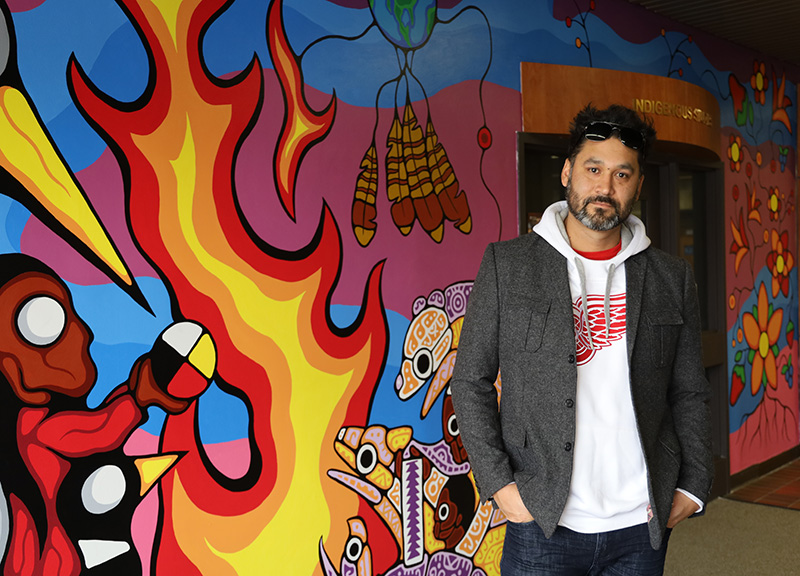News and Updates
Contact
Faculty of Social Science
Social Science Centre
Room 9438
Western University
T. 519-661-2053
F. 519-661-3868
E. social-science@uwo.ca
New Indigenous mural honours community voices on campus
February 24, 2023
Story and photos by Rob Rombouts
Two bears climb trees, acting as protectors as animals gather around a sacred fire. Flowing behind it all are the waters of the Deshkan Ziibi.
This scene is part of a new mural outside the Indigenous Studies office on the third floor of the Social Science Centre at Western. The mural has been created by students, staff and faculty connected to the program.
Mike Cywink, an Indigenous Studies student and staff member at Western, designed the mural with input from the community.
Cywink, who is Ojibwe from Whitefish River First Nation, has completed numerous other mural projects working with community groups, including one outside the N’Amerind Friendship Centre in London, Ont. that honours survivors of the residential school system.
For the Western project, Cywink wanted to make everyone feel welcome. “If we are going to do a piece here, that (community) representation matters. That student voice, faculty voice, everyone who calls Western home should have a say into what goes in it,” he said.
Cultural representation
The mural includes cultural representation of three different Indigenous nations – the Anishinaabek, the Haudenosaunee and the Lūnaapéewak – and elements reflecting the concerns, hopes and aspirations of students and the community.
The crane, loon and fish represent Anishinaabek clans. The Lūnaapéewak people are represented through the inclusion of turkey feathers, a turtle and a wolf. Artist Tsista Kennedy provided the artwork for the Oneida clan animals – the turtle, wolf and bear.
“Even though it’s an entire Indigenous mural, each of those different nations have different teachings and cultures and languages. We wanted to make sure we included aspects of each one,” said Cywink.
Orange and red flowers represent ongoing issues, the #EveryChildMatters movement and Missing and Murdered Indigenous Women.
Two bears on trees flank the art. The trees themselves, painted in purple, reflect Western. Each tree has seven white sections, representing the idea of seven generations.
“From our teachings, the bear, the mukwa, is seen as a protector, looking out for the people,” said Cywink. “I wanted to make sure to include that, because it should be everyone’s responsibility to look after the safety of others, as they should for you.”
Community consultation process
The mural comes after a consultation process with students, staff, faculty and community members, and began when Chantelle Richmond, professor in the department of geography and environment, was serving as interim director of the Indigenous Studies program. Through discussions of refocusing the program, and making a space for the program, Richmond suggested the mural.
“So many indigenization efforts take on really symbolic gestures — but this mural project was meant to physically, culturally, socially claim space and to make it one where we imagine our own selves and the futures we want to see at Western,” she said.
Through the fall term, Rick Fehr, Indigenous Studies program coordinator, convened coffee hours, inviting people to share their thoughts on what should be represented.
“I found that the Indigenous Studies student body – both Indigenous students and non-Indigenous allies – were on board right from the beginning. One thing they were never short on was ideas,” said Fehr. “I give all the credit to Mike who, as the artist, has this monumental task of crafting a narrative of all these ideas.”

Mike Cywink, an Indigenous Studies student and staff member at Western, designed the mural with input from the community.
Creating a welcoming space
Following the consultation and design phase, community members were invited to take part in the painting. Staff, faculty and students from the program, as well as many other members of the Western community joined in. In total, Fehr estimates around 25 people picked up brushes to paint the mural.
Rolla Kristoffsdottir attended planning meetings and took part in the painting. The first-year Indigenous Studies and French student said she enjoyed working on the community project with other Indigenous people.
“I think the energy is different when it’s Indigenous people working on things,” she said. For her, the mural will be a way to show other Indigenous students they belong at Western. “It’s important to have voice and representation for Indigenous people.”
The mural is intended to create a welcoming space for current as well as future students.
“We hope they go ‘wow, we can relate to this, and this is our space’,” said Lewis Williams, professor of Indigenous studies and geography, and interim director of the Indigenous Studies program.
“This is a celebration, there’s a sense of belonging here, for Indigenous peoples in particular. The local communities – Chippewa of the Thames, Oneida of the Thames, Munsey-Delaware – because of the representation that’s woven into this mural, will feel a greater connection to Western. That’s really important, to strengthen those relations,” she said.

